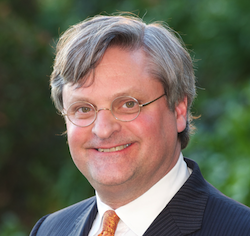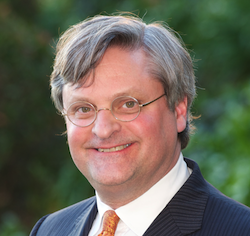
“Battery” is the term applied to the special relationship of pitcher to catcher, one of the most visible in baseball. Not far from AT&T Park, where the division-leading San Francisco Giants have been powered by several strong batteries, a comparable pair of team leaders has been working out of the headquarters of the New Century Chamber Orchestra. They’re Nadja Salerno-Sonnenberg, the NCCO’s music director since 2008, and Parker Monroe, who might be said to be in his last inning, after 18 years, as the ensemble’s executive director. “Whether through touring, recording, new partnerships, innovative education programs, or commissioning programs, Parker’s stalwart leadership put New Century on the musical map,” board President Mark Salkind testified in a press release announcing the retirement.
Beyond these functions, Monroe, with an impressive knowledge of string orchestral repertoire, had helped Salerno-Sonnenberg assemble the dazzlingly diverse programs that have packed audiences at NCCO performances. He’d served previously in similar functions for orchestras on both West and East Coasts. Over lunch at the Paragon gastropub, close to both the ballpark and his office, Parker chatted with SFCV about his career and his imminent change of lifestyle.
What are the current standings of the NCCO among similar ensembles?
There are lots of chamber orchestras in the United States. We’re actually in a commissioning consortium next year, with a group of the best American orchestras. As for conductorless chamber orchestras, we are the only one I’m aware of on the West Coast. And, in any case, we are probably the very best at what we do, in the U.S. — which is, a collective decision-making conductorless ensemble that decides as a group about the interpretation of the music. There are a number of orchestras internationally that are somewhat like us. Probably the best-known is Kremerata Baltica, which is Gidon Kremer’s group.
Where had you worked before we got ahold of you?
Just before, I was at what’s now called the Boston Youth Symphony, for eight years. The two orchestras before that were short tenures, but one of them was not my fault. The first was the old Oakland Symphony Orchestra. I started there [around the time] Calvin Simmons died in a boating accident. Every now and then, the Oakland Symphony could have a better night than the San Francisco Symphony could, in terms of the quality of performance. I was there until the board made the pretty weird decision to declare Chapter 7 bankruptcy, when they told us to not deposit our paychecks, but to cash them.
And what drew you back to the Bay Area?
I was working in Boston, and liked my job there; we did all sorts of exciting things. But an old friend of mine from Kenyon College who was out here told me about this [NCCO] job and said, I know there are things you miss. I missed the San Francisco Symphony and their spirit of adventure. I missed the Opera, because Boston’s a great orchestra town, but not a great opera town. And I missed the natural beauty of the place. It was a hard winter — the winter of ’96 — and I figured, I’m ready to take a break from the snow.
What did you know about New Century?
I’d heard cassette tapes. And I knew some people in the Boston Symphony, and everybody there knew who Stuart Canin was [NCCO music director from 1991 to 1999, and former concertmaster at the S.F. Symphony and Opera Orchestra], and they said that the New Century was in the enviable position of rehearsing eight or nine times for a concert. In my interview, I talked with Stuart Canin, and there were a lot of his orchestra people there. It was sort of a Papa Bear/Baby Bears situation, and I wondered about the functionality of that. (As it turned out, there were issues with that from time to time, because Mr. Canin was an old-school guy.) But what struck me was, this was an opportunity to make a mark with something new. They needed to sell a lot more tickets, but the money was generally in place. And there was a commitment to quality, they were doing adventurous repertoire, they had ongoing relationships with composers, and they were already touring. The atmosphere in the place was, let’s do it!
Was it hard work?
They’d had an executive director previously, and I don’t think he was on the job long when he got chronic fatigue syndrome. But I’d already been working 60 hours a week in Boston, and I’d been able to observe the impact strong management can have on orchestras. I got back here in the early ’80s, right after Davies Hall was finished and the San Francisco Symphony players split from the Opera Orchestra. And the Symphony began this trajectory they’ve been on for the last 30 years, of excellence.
We are probably the very best at what we do, in the U.S. — which is, a collective decision-making conductorless ensemble that decides as a group about the interpretation of the music.
So it was the right environment for you.
The Symphony served as an inspiration to all those who said the orchestra is dead, it’s a fossil. They kept getting better, and that’s what management can do: Make good selections about conductors to lead the group, build a board that will raise the money. And [make] canny decisions about what music you’re gonna record, and when, and how you’re gonna promote that music. I sought out [former SFS Executive Director] Peter Pastreich; he offered me advice on boards, music director searches, recordings, unions and collective bargaining, and crisis management. I went to him once with a very detailed presentation, and he said, “I think you say ‘I’ too much.” The implication was, be more respectful of my colleagues. It was a wake-up call, or more, a grow-up call. He would have been at my wedding last year, but he was mediating contract negotiations with the Seattle Symphony.
Who is your bride?
She’s on the New Century board; her name is Teresa Darragh. She came to a New Century concert at St. John’s Presbyterian Church in Berkeley, I started talking to her, and we just hit it off. She came on the board while we were still dating, and the board said, she has to recuse herself on this and that and can’t vote on compensation or on anything dealing with me directly. And she’s proved to be an extremely good board member. She has appointments in pathology and gynecology at UCSF, but she likes to go on tours, to get out of the office. We joke that we’re the only orchestra in America that travels with its own gynecologist. But the orchestra is 75 percent women!
So how have you channeled Pastreich’s advice and established your own style at NCCO?
I work in meetings and behind the scenes to hoist sails and take down sails, work the rudder, and set the course. And I have always been more effective working in the background. So you don’t see an executive director’s message in the program booklet, or plastered all over the website. I’ve had a good tenure through three music directors, two [board] presidents, and a variety of people in various staff positions. And I had the great good fortune, for 16 of my 18 years here, of working with an absolutely incredible president, Paula Gambs. To tell you the truth, she’s the reason I stayed as long as I did, because she’s such an incredibly nice person. She used to go to all the rehearsals, she’d take the orchestra out to lunch or bring in food, and she still comes to virtually all the concerts.
There was a commitment to quality, they were doing adventurous repertoire, they had ongoing relationships with composers, and they were already touring. The atmosphere in the place was, let’s do it!
One of the challenges about being an executive director is, as Peter would put it, you spend as much time swatting away bad ideas as you do encouraging good ones. One of the main sources of ideas is the music director, and that relationship can be blissful and incredibly productive, or it can be the other way. And I’ve had both at the NCCO. Some people were just not up to the job, not natural leaders. They didn’t inspire the musicians or the audiences, and didn’t leave the audiences saying, “Wow, what are they gonna do next time? I wanna go!” Frequently, dealing with music directors, you have big egos you have to deal with. That goes with the job, because that ego is what can translate into charisma on the stage. But what’s great about Salerno-Sonnenberg is, even when you’re on the phone with her, there’s no bullshit at all; she’s just very practical, she tells you how it is. You don’t have to go through veils and layers of meaning. And by the time we signed our first contract with her, she was talking about taking us to the next level, which we all wanted to do. She said we’re gonna do national touring, we’re gonna step up the quality, we’re gonna go back to making records again, and we’re gonna get this orchestra all over the radio, and increase its profile in the Bay Area. And she’s done all those things! We had a record come out just last week; it’s four concertos we commissioned [From A to Z: 21st Century Composers].
Dealing with music directors, you have big egos you have to deal with. That goes with the job, because that ego is what can translate into charisma on the stage. But what’s great about Salerno-Sonnenberg is … she’s just very practical, she tells you how it is.
So are you ready to leave all that?
I am still there. The search committee [for his replacement] hired a symphony orchestra management specialist named Catherine French, former president of the League of American Orchestras, and she’s doing the search. They’ve done a bunch of preliminary interviews, and now they have to fly the finalists in to San Francisco. My boss, Mark Salkind [his father, Milton, was president of the San Francisco Conservatory)], said I should anticipate that they will have a contract signed by July. So I’m gonna stay until the new executive director has his or her bags unpacked, and then I’ll talk to the person on the phone and say I’m gonna get out of the way now. Any introductions you’d like me to make — to people from Classical Voice, to Mr. [Gordon] Getty, to the Hewlett Foundation, whoever it might be — I’m glad to do that.
What will you do with all the time you’ll have?
I began last September with a master’s in literature at Stanford; it’s for people who are working or who are not freshly minted from undergraduate institutions. What I’m looking at is comparing Brecht’s epic theater, which was very didactic and Marxist and all that, with Woody Allen’s, who actually uses a lot of Brechtian techniques. I’m still in the coursework phase, but I love my classmates. Also, I have parents in Hingham, Massachusetts, who are in the final stages of their lives, so I’ll be going back there about once a month.
Will the transition be tough on you?
I’ve been an orchestra executive director since I was in my mid-20s, and I’m now 55, so I’ve been doing it for 30 years. And I think it’s gonna take a little bit of getting used to, not being the boss. But counterbalancing that is, I won’t have to raise money 365 days a year. It’s exhausting! There will be ongoing ties, because I have my season tickets already for next year. I’ve always felt that if it were possible to make a generous cash contribution, I should do that, and I’ll continue. So I’m switching from being the CEO to being a volunteer and an investor.

